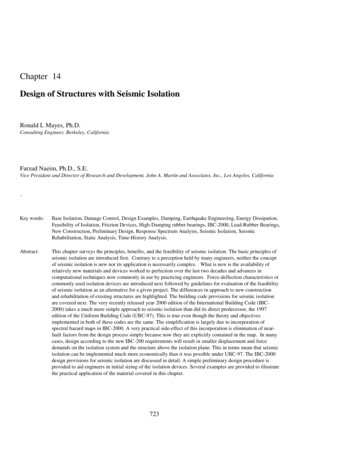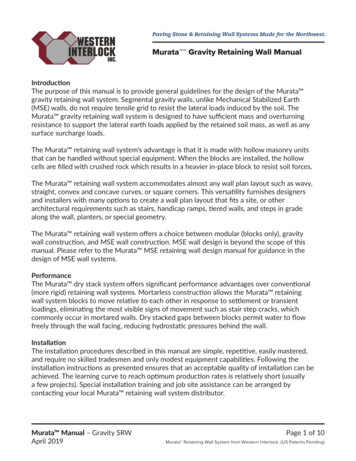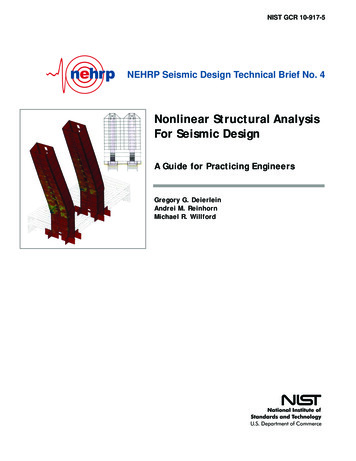
Transcription
International Journal of Engineering Research & Technology (IJERT)ISSN: 2278-0181Vol. 3 Issue 7, July - 2014Base Isolation In Seismic Structural DesignDr. R. S. Talikoti,Mr. Vinod R. Thorat,Department of Civil Engineering, PtofrssorLate G. N. Sapkal College of Engineering, AnjaneriNashik-422413, Affiliated to Pune University, India.Department of Civil Engineering, P.G. StudentLate G. N. Sapkal College of Engineering, AnjaneriNashik-422413, Affiliated to Pune University, India.Abstract---Numerous attempts on research and development foranti seismic structures or the structures that can withstandseismic hazards and lend some ground resistance in earthquakeshaven’t yielded any satisfactory conclusions. Even though afterdecades of study and implementation of advanced designing,execution and maintenance tactics in high rise structures, manyconstruction aspects have found a new ways to deal withstructural hazards, yet the concerns of seismic hazards arerelatively found unanswered. These seismic hazards are primematter of concern in Earthquake prone zones or the seismiczones worldwide.Earthquakes are unanticipated phenomena if the structure islocated in seismic zones. The structural engineer has to stepin so as to save lives and cause minimal damage to thestructures in times of earthquake. The recent development foranti seismic designs is base isolation, which may not reducethe ground movement but would help in keeping the impactof ground movement to its minimal extend.IJERTOver the period of time the research on structural dynamics,study and analysis of the same are carried on using series ofearthquake movements by means of varying the earthquake orthe seismic intensity. Studies shows those analyses were beingperformed on a fixed based structures, whereas here it couldalso be performed on isolated structures with nonalignedisolator elements. As per the analyses with effect of isolatedstructures, it was discovered that the isolators minimize thelateral load imposed on the structure and in accordance to thatit also tend to reduce the size of the building components.sum of forces. The maximum point at which the structure candeform and come to its original shape is called as Elasticlimit. If building deforms more than its elastic limit, it formscracks in the structure. However, ductility will induce someacceptable damage to the structure. But if more elasticity isintroduced to the structure, it may tend to increase the overallcost and decrease the damage by increasing the strength,which in turn will be harmful to the components of thebuilding with less strength.Base isolation has turned out to be a trending design over pastfew years; here we take a detailed glance at the designing,working, testing as well as the suitability of base isolation designas per Indian Standards. The study would also comprise use ofnew designing software’s for the analysis taking a buildingstructure as a model in consideration for case study and laterconcluding the subject post results. The probable merits of baseisolation over the conventional approach of dynamic analysiswill be discussed.Key.words—Sap2000, Time History Analysis,Base Isolation, Lateral displacement,INTRODUCTIONThe naturally occurring ground movement which eventuallygoes on creating disasters such as failure of structure andfatality is known as Earthquake. The energy that isdischarged from those seismic activities makes waves, thesewaves are called as primary waves and secondary waves.These waves cause ground movement transmitted to thestructure via foundation. Depending on the intensity of thesevibrations, cracks and settlement is caused to the structure.Inertia force is induced in structure because of thisearthquake movement as result damage of the structureincreases with the ground motion. It’s permissible to theengineers to use ductility to attain more deformation on thestructure than the permitted elastic limit by increasing smallIJERTV3IS070888Base isolation system is the frequently adopted earthquakeresistance system. It reduces the effect of ground motion andthus leads to nullify the effect of earthquake to on thestructure. Base isolation has become popular in last couple ofdecades in its implementations in buildings and bridges. Baseisolation has become a traditional concept for structuraldesign of buildings and bridges in high risk areas. Many arebeing already constructed and many are under construction.When Base Isolation in a seismic Structural Design ofearthquake occurs, the ground moves laterally and damagesthe structure. Bifurcating the structure form the ground byintroducing flexible isolation system between the foundationand the structure is the solution to this problem. This systemwill absorb the shock impact effects of earthquake with thehelp of its flexibility. This way the seismic energy transmittedto the structure will be reduced to greater extent and thestructure will remain stable for a relative period. Baseisolation increases the natural period of the structure and soreduces the displacement of the structure during seismicevent. Rubber bearing and lead rubber bearing are primefactors used to introduce flexibility in the structure. Thisincreased the natural period of the structure and basedisplacement is more than prearranged limit. Though, baseisolation not always liable to work against the strongearthquakes as it may result in larger displacement at the baseof the structure.as suggested in its name –Base a part that supports from beneath or serves as awww.ijert.org863
International Journal of Engineering Research & Technology (IJERT)ISSN: 2278-0181Vol. 3 Issue 7, July - 2014foundation for an object or structure.Isolation the state of being separated, and(definition according to Concise Oxford Dictionary), is thatof decoupling a structure from its foundation, separating thesuperstructure from the columns or piers .structure as the stiffness of the structure also decreases.Generally, the isolation is placed at the base of the structure,Base isolation protects the building components of thesuperstructure during earthquakes. The acceleration in thesuperstructure and the inertia forces induced in the structureare reduced considerably due to isolation.Fig. No.02 Increasing displacement and decreasingincreasing periodacceleration withThe principle in base isolation,Isolation To provide horizontally flexible as well as verticallystiff to the building. To lengthening the natural period of the building. Damping in the Isolation system reduces thedisplacement. It also reduces in the acceleration of the story.IJERTFig. No. 01 Performance Of Building with & withoutII. THE CONCEPT OF BASE ISOLATIONBasic principle of base isolation is to differentiate thebuilding from its foundation, so during the seismic action,building is stays unaffected from the ground motion. In otherwords, even though ground moves aggressively, the buildingwill tend to move ideally as a rigid body rather thancollapsing. This reduces the floor hastening and storeygliding and so the building components are left less harmed.In the model, separation is total but practically, there is someco relation between the ground and the building whichprovides flexibility to the structure. Any stiff structure willhave short period. During the ground movement, amount ofacceleration entrusted in the structure is the same of groundacceleration that results in zero displacement between thestructure and the ground. In other words, ground andstructure will move with equal amount.Flexible structure will have longer life span. In this particulartype of structure, when the ground moves, no acceleration isintroduced in the structure. Displacement between thestructure and the ground is the same to the amount of grounddisplacement. In other words, ground will move but not thestructure.Base isolation system should contain following:1. An elastic mount to add enough vibration periods to thestructure to lower down the forces in the structure over.2. An energy dissipater or damper to ease the deflectiontaking place between the structure and the ground.3. Introducing the stiffness against the seismic actions andwind loads.Base Isolation ConsiderationBase isolation is required if any circumstances arise of thefollowing:-Base isolation increase the flexibility of the structure andhence increases the period of the structure which is due to theisolators. The effect of period shift is shown in figureintroducing the base isolation in the structure increases thedisplacement and eventually decreases the acceleration in theIJERTV3IS070888www.ijert.org1.Need to increase the safety of the structure.2.Low lateral seismic forces needed.864
International Journal of Engineering Research & Technology (IJERT)ISSN: 2278-0181Vol. 3 Issue 7, July - 20143.Any existing building is not capable to withstandany earthquake.4.Withstand small earthquakes without any damage.5.Structure will not collapse in high level earthquakebut some structural and non-structural damage willoccur.2. Lead Rubber Bearing (LRB)The LRB was first used in New Zealand in1975 and wasfrom then onwards used on large scale in New Zealand, Japanand United States. These are same laminated as low-dampingrubber bearings. One or more than one lead plugs areinstalled in the bearings which support the structure andprovides along the ground flexibility to the structure.III. DIFFERENT TYPES OF SEISMIC ISOLATORThe most common use of base isolator in building is1.Laminated Rubber (Elastomeric) Bearing.a. Natural and synthetic rubber bearing(low damping).b. Natural rubber bearing (high damping).2.3.Lead Rubber Bearing (LRB)Friction Pendulum (FPS) System Bearing1. Laminated Rubber (Elastomeric) BearingLow Damping Rubber Bearing:Fig. No.04 Lead Rubber Bearing (LRB)3. Friction Pendulum bearingsIJERTIt is made of alternate layers of natural rubber that provideflexibility and steel reinforcing plates that leads to verticalload-carrying capacity. At the top and bottom of these layersare steel laminated plates which distribute the vertical loadsand transfer the shear force to the internal layer of rubber.This system of elastomeric bearing is variedly used inresidential buildings, hospitals and halls constructed on thesubway or railroads.High Damping Rubber Bearing: -Single pendulum bearing and triple pendulum bearing are twodifferent types of friction pendulum bearings. Two horizontalsteel plates slide over each other during the earthquake. Inother words the ground movement only takes place on thebearing and the structure stays as it is. Those bearings arestrong enough to carry the weight of the building.It is similar to elastomeric bearings where the elastomericused ( either natural or synthetic rubber) provides asignificant amount of damping The damping in the bearing isincreased by adding extra-fine carbon block, oils or resinsand other proprietary fillersFig.05 Friction Pendulum bearingsI. Case study of Commercial buildingFig. No.3 Laminated Rubber (Elastomeric) BearingIJERTV3IS070888The (G 15) RCC building is considered for the case study.Its modeled in SAP2000 software and analyzed for fixedbase, bracing and Isolator. The non-linear time intervalsanalysis is carried out by considering El-Centro time historyground acceleration data. Theoretical comparison is thenwww.ijert.org865
International Journal of Engineering Research & Technology (IJERT)ISSN: 2278-0181Vol. 3 Issue 7, July - 2014worked out between the fixed base and the base isolatedstructure and the parameters such as base shear, mode period,storey displacement, storey drift and storey acceleration byusing SAP2000Building Details :Table No.1 Building DataGrade of concreteM3002Grade of steelFe41503.StoryG 1504Size of beam230mmX450mm05Size of column600mmX600mmO6Wall thickness230mm07Slab thickness150mm08Plinth height1.5m09BracingISA 150X150X1509Story height3m10Live load3KN/m11Floor finish1.5KN/mIJERT01.Fig. No.07 Elevation of buildingIV ResultsTable No.2 Time period in secondFixed 16A. Base ShearFig. No.06 plan of buildingThe graph shows (Fig.8 & Fig.9) the maximum base shearboth in X & Y directions.Fig. No.8 Base Shear -XIJERTV3IS070888www.ijert.org866
International Journal of Engineering Research & Technology (IJERT)ISSN: 2278-0181Vol. 3 Issue 7, July - 2014C. Storey DriftThe graph (Fig.12 & Fig.13) shows the storey drift for thestructure, both in X and Y direction respectivelyFig. No.09 Base Shear –YB. Storey DisplacementThe graph (Fig.10 & Fig.11) shows the storey displacementfor the structure, both in X and Y direction respectively.IJERTFig. No.12 Story Drift – XFig. No.10 Displacement-XFig. No.13 Story Drift – YV . CONCLUSIONS Effectiveness of isolation technology can beperceptible when it is compared to the resultsobtained from the analysis of non-isolatedbuildings. Base isolation system is an extraordinary andwidely recognized advancement that is used tosave innumerable lives and money spend indestruction made my earthquakes.Fig. No.11 Displacement-YIJERTV3IS070888www.ijert.org867
International Journal of Engineering Research & Technology (IJERT)ISSN: 2278-0181Vol. 3 Issue 7, July - 2014 From the above result base shear is decreasewhile the using base isolator Base isolator is minimize displacement and storydrift in both the direction as compared with othersystem. Time period of both the base isolated structures i.e.LBR and HDRB increases as compared to the fixedbase structure, but it decreases with the bracing VI. REFERENCES2.3.4.5.6.7.N. Naeim , J.M.Kelly, “ Design of Seismic Isolated Structures fromTheory to Practice”, The reference book, 1999. Sarvesh K. Jain an, Shashi K. Thakkar, Application of base Isolationfor Flexible Buildings” ,13th World Conference on EarthquakeEngineering Vancouver, B.C., Canada [August 1-6, 2004] Paper No.1924S.M.Dhawade, “Comparative study for seismic performance of baseisolated , fixed base RC frame structure” International journal of civilengineering research, [2014] vol.5, pp.183-190.Dr. Hadi Nasir Ghadhban AL-Maliki, “Analytical Behavior of MultiStoried Building with Base Isolation Subjected to EarthquakeLoading”, Journal of Engineering and Development, Vol. 17, No.2,[2013] ISSN 1813- 7822Abrishambaf, Amin, “ Principles and Practices of Seismic IsolatedBuildings”. Masters. Cyprus: Eastern Mediterranean University.[2009.]S.Duggal, Earthquake Resistat Design of Structures, New Delhi:Oxford.[2007]CSI Analysis Reference Manual forSAP2000 .IJERTV3IS070888IJERT1.www.ijert.org868
Base Isolation In Seismic Structural Design. Dr. R. S. Talikoti, Department of Civil Engineering, Ptofrssor . anti seismic structures or the structures that can withstand seismic hazards and lend some ground resistance in earthquakes . so during the seismic action, building










